Nuclear–Thermal Power Generation: Multicriteria Optimization of the Economic Sustainability
Abstract
1. Introduction
- Efficiency improvements, such as optimizing energy production in hybrid systems, contribute to economic sustainability by lowering operational costs and enhancing resource utilization.
- Renewable energy sources, such as solar and wind, are being integrated into power generation due to their lower environmental impact and potential for cost savings. Hybrid systems with renewable sources address energy variability needs and improve economic sustainability. Hybrid generation with nuclear energy is decarbonizing global energy as part of solutions to boost clean energy in power systems [2].
- Economic sustainability can be assessed using financial metrics such as the levelized cost of energy, net present value, or payback period, which determine the profitability and cost-effectiveness of power plants.
- The adoption of advanced technologies, upgrades in thermal power plants, or hybrid models enhance their economic performance by improving efficiency and adapting to fluctuating power demands, causing financial viability and long-term profitability.
- Economic sustainability is linked to environmental and social factors too. Reducing carbon emissions and adopting sustainable practices can improve public perception and long-term viability. Economic sustainability requires supportive policies and financial incentives to overcome initial investment barriers, especially for emerging technologies.
- A significant reduction in carbon emissions and decrease in greenhouse gas emissions by minimizing reliance on diesel generators.
- Enhanced energy access and reliability in isolated regions where hybrid systems have replaced diesel generators, providing consistent electricity for lighting, refrigeration, and communication.
- Economic advantages: while the initial investment in hybrid systems can be substantial, they offer long-term cost savings by reducing fuel expenses and maintenance costs associated with diesel generators.
- Scalability and adaptability. Hybrid systems can be tailored to the specific energy needs and resource availability of different communities.
2. System Description
- Capacity factor reduction: frequent changes in the power output reduce the capacity factor (the time the reactor is running at the rated power), impacting the revenue per MWh.
- Automation and O&M: SMRs are designed for lower staffing and automated control, which could reduce costs associated with more complex kinetics control.
- Faster ramps could increase thermal stress and O&M costs unless materials and systems are specifically engineered to handle it.
- SMRs, particularly those operating without soluble boron, rely on mechanical control systems, which can cause higher local power peaking during rapid load changes. Boron-free designs with continuous control rod insertion increase reactivity feedback complexity and risk fuel hot spots under rapid power transients [53].
- Ramp rate limitations are not only thermal–hydraulic (coolant temperature lag), but are also driven by cladding strain limits and peak linear power constraints, affecting fuel safety margins.
- A shortened fuel life: cycling can reduce the burnup efficiency, increasing the refueling frequency and waste.
- More rigorous fuel performance monitoring is needed, increasing operational costs.
- Advanced fuel premium: SMRs using resilient fuels (metallic or TRISO) may have higher upfront fuel costs, but lower degradation in the variable mode.
- Cyclic thermal and mechanical loading during ramping operations leads to enhanced fission gas release, accelerated cladding creep and oxidation, and an elevated risk of pellet-clad interactions.
- Advanced cladding materials (Cr-coated zirconium, FeCrAl) mitigate these effects, but exhibit mixed results depending on the power peaking and core design [54].
- Increased fuel costs: more frequent fuel replacement due to accelerated degradation raises the cost per megawatt-hour (MWh) of electricity produced;
- Maintenance and downtime: additional inspections and unscheduled maintenance can lead to increased operational expenditures and reduced availability;
- Waste management: higher volumes of spent fuel and associated radioactive waste necessitate expanded storage and disposal solutions, further increasing costs.
- Advanced fuel materials by using cladding materials with improved resistance to thermal and mechanical stresses can extend fuel life.
- Optimized reactor operation by implementing control strategies that minimize rapid power changes to reduce stress on fuel components.
- Predictive maintenance by utilizing machine learning and AI-driven models to predict fuel degradation enables proactive maintenance, reducing unexpected downtime [59].
- Storage costs: On-site storage remains the most economical option, especially for early SMR deployment phases. However, with a proliferation of SMRs across distributed sites, the cumulative cost of maintaining multiple secured storage units increases.
- Cost sensitivity: the price of dry storage casks is a significant cost driver; SMRs producing more reactive fuel require more robust (and expensive) cask designs [60].
- Transportation and centralized disposal: More numerous and smaller sites translate to higher transportation costs and infrastructure redundancy. The chemically reactive and heterogeneous waste stream may limit options for co-disposal with conventional LWR waste, necessitating new disposal strategies. Local on-site storage is most cost-effective, but an SMR increases costs and transportation complexities [60].
- Repository design and lifecycle costs: SMRs are likely to increase the total repository footprint needed due to a higher waste volume per unit of energy. Waste packages might require enhanced engineered barriers, further elevating disposal costs.
- Multiphysics simulations link thermal, mechanical, and chemical degradation mechanisms [62] and reviews failure mechanisms in ferritic and austenitic cladding materials under extreme conditions, highlighting modeling needs.
- Time-series and machine learning methods: used in structural health monitoring to extrapolate long-term behavior from in-service data [63].
3. Modeling the System
- Fuel costs, mainly of uranium or plutonium.
- O&M costs including employee remuneration, equipment maintenance, and overheads.
- Decommissioning costs for dismantling equipment and the disposal of radioactive waste.
- Insurance, regulatory compliance, and licensing costs related to nuclear operations.
4. Scenarios Studied
- Scenario 1: the SMR generates a constant output power and the three thermal units generate varying outputs;
- Scenario 2: the SMR generates load-following output power and the three thermal units generate varying outputs;
- Scenario 3: the SMR is deactivated and the three thermal units are activated and generate varying outputs. This operation is the base case study for the comparison of the results obtained by activating the SMR in Scenarios 1 and 2.
4.1. Scenario 1: Nuclear Reactor Generates Constant Power; Three Thermal Units Generate Varying Outputs
4.2. Scenario 2: Nuclear Reactor Generates Load-Following Output; Three Thermal Units Generate Varying Output
4.3. Scenario 3: Nuclear Reactor Is Deactivated; Three Thermal Units Generate Varying Output
5. Results and Discussion
- In Scenario 1, at the minimum limits of powers, , , and , between the hours of 24:00 and 9:00, 23:00 and 11:00, and 2:00 and 8:00, respectively. Therefore, during the 24 h, the three thermal units will generate at , , and .
- In Scenario 2, at the minimum limits of powers, , between the hours of 3:00 and 7:00, between 1:00 and 9:00, and between 3:00 and 7:00, respectively. Therefore, during the 24 h, the three thermal units will be at , , and .
- In Scenario 3, at , , and between 22:00 and 11:00, and between 11:00 and 22:00. In Scenario 3 with the SMR deactivated, the Th3 worked at a maximum capacity during the night, 22:00–11:00, and this fact indicates the most polluted situation.
- The minimal cost powers generated and the reserves of power versus ;
- Total minimal costs of power generated by nuclear reactor and by three thermal units during 24 h;
- The total powers generated by a nuclear reactor, by three thermal units, the reserves of power, and the electrical load during 24 h;
- Balance of total powers generated from nuclear and thermal sources and the reserves of powers;
- Total optimal costs of powers and the varying lambda versus time for the three scenarios;
- The results for optimal energy (MWh), optimal costs (Eur), and optimal cost/energy (Eur/MWh);
- The mean minimum costs of energy and power generated for the three scenarios;
- The differences between applying three scenarios in terms of mean minimum costs of energy and power generated;
- The CO2 emissions of lignite thermal units and the savings of CO2 emissions due to introduction of a nuclear reactor.
- Study [39] discussed the economic and strategic aspects of small modular reactors (SMRs), highlighting their potential for integration into hybrid systems.
- Study [41] provided a critical assessment of SMRs, questioning their economic viability and scalability.
- Study [83] explored the compatibility of nuclear power with renewable energy sources, emphasizing the need for flexible operation.
6. Conclusions
Funding
Institutional Review Board Statement
Informed Consent Statement
Data Availability Statement
Conflicts of Interest
Abbreviations
| Lambda, variable corresponding to incremental cost rate | |
| Small variations of lambda | |
| Function expressing the power balance constraint of the hybrid system | |
| Function expressing the power balance constraint of thermal system | |
| Total costs of the nuclear unit | |
| EMS | Energy Management System |
| , | Cost rate of nuclear reactor |
| Objective function, the total operating cost rate of the thermal generators | |
| Cost rate of thermal unit | |
| Objective function, total operating cost rate of the hybrid system | |
| Total operating cost rate of thermal generators | |
| Total operating cost rate of nuclear reactors | |
| Matrix of fuel costs of thermal units | |
| Fuel cost of thermal unit | |
| Matrix of minimal operational costs of thermal units | |
| Total minimal costs of thermal units | |
| Total minimal costs of thermal power plant | |
| Heat rates coefficients | |
| Heat rate of thermal unit | |
| Number of thermal units | |
| Number of nuclear reactors | |
| Lagrangian function | |
| Total number of thermal units | |
| Total number of nuclear units | |
| O&M | Operation and Maintenance |
| Power generated by thermal unit | |
| Power generated by nuclear reactor | |
| Electrical load | |
| , | Limits of generation of thermal units , minimum values, maximum values |
| Nuclear power output to the power system | |
| Nuclear power of reactors | |
| Maximum value nuclear power of reactors | |
| Matrix of optimal costs’ thermal powers | |
| Reserve of power | |
| SMR | Small modular reactor |
| Thi | Thermal unit |
| Cost coefficient of the nuclear unit | |
| Duration of time |
Appendix A
| Thermal Units | (MW) | (MW) | Locations: Peloponese, Greece [68] | |||
|---|---|---|---|---|---|---|
| Th1 | 70 | 130 | 0.00507 | 0.9300 | 55.185 | Megalopoli 1, Megalopoli 2. |
| Th2 | 150 | 300 | 0.00079 | 1.5520 | 56.318 | Megalopoli 3. |
| Th3 | 150 | 300 | 0.00034 | 1.6620 | 31.164 | Megalopoli 4. |
| Rated Power: | 140 MWe |
| Efficiency: | 45% |
| Main Temperature: | 585 °C |
| Reactor Outlet Temperature: | 650 °C |
| Intermediate Salt: | “Solar”/Nitrate Salt |
| Refueling Type: | Online |
| Fuel Type: | Lignite | Hard Coal | Natural Gas | ||||||
|---|---|---|---|---|---|---|---|---|---|
| Old | Modern | Mean | Old | Modern | Mean | New (Turbine) | New (CCGT) | Mean | |
| Direct CO2 emissions. (*) | 1173 | 831 | 1049 | 939 | 663 | 867 | 512 | 340 | 358 |
| CO2 emissions including upstream chain. (**) | 1200 | 850 | 1073 | 1051 | 742 | 970 | 624 | 415 | 436 |
References
- Kartal, M.T.; Santosh, M.; Ulussever, T.; Pata, U.K.; Depren, S.K. A comprehensive review of progress in sustainable development goals from energy and environment perspectives. Energy Strategy Rev. 2024, 56, 101550. [Google Scholar] [CrossRef]
- Froggatt, A.; Schneider, M. Nuclear Power Versus Renewable Energy-A Trend Analysis. Proc. IEEE 2015, 103, 487–490. [Google Scholar] [CrossRef]
- Alonso, G.; Bilbao, S.; del Valle, E. Economic competitiveness of small modular reactors versus coal and combined cycle plants. Energy 2016, 116, 867–879. [Google Scholar] [CrossRef]
- Ioannides, M.G.; Stamelos, A.; Papazis, S.A.; Papoutsidakis, A.; Vikentios, V.; Apostolakis, N. IoT monitoring system for applications with renewable energy generation and electric drives. Renew. Energy Power Qual. 2021, 19, 565–570. [Google Scholar] [CrossRef]
- Papazis, S.A.; Ioannides, M.G.; Fotilas, P.N. An information system for the multiple criteria assessment of renewable energy power plants. Wind Eng. 2000, 24, 81–99. [Google Scholar] [CrossRef]
- Behera, S.; Barisal, A.K.; Behera, S.; Bagal, D.K. Combined Economic Emission Dispatch including Variable Energy Resources. Curr. World Environ. 2024, 19, 2. [Google Scholar] [CrossRef]
- World Nuclear Association, WNA. World Nuclear Performance Report. Available online: https://world-nuclear.org/images/articles/World-Nuclear-Performance-Report-2024.pdf (accessed on 27 November 2024).
- EIA Energy Information Administration. Available online: https://www.eia.gov/tools/ (accessed on 21 July 2024).
- Papazis, S.A. Integrated Economic Optimization of Hybrid Thermosolar Concentrating System Based on Exact Mathematical Method. Energies 2022, 15, 7019. [Google Scholar] [CrossRef]
- Olabode, O.E.; Ajewole, T.O.; Okakwu, I.K.; Alayande, A.S.; Akinyele, D.O. Hybrid power systems for off-grid locations: A comprehensive review of design technologies, applications and future trends. Sci. Afr. 2021, 13, e00884. [Google Scholar] [CrossRef]
- López-Castrillón, W.; Sepúlveda, H.H.; Mattar, C. Off-Grid Hybrid Electrical Generation Systems in Remote Communities: Trends and Characteristics in Sustainability Solutions. Sustainability 2021, 13, 5856. [Google Scholar] [CrossRef]
- Aghapouramin, K. Technical, Economical, and Environmental Feasibility of Hybrid Renewable Electrification Systems for off-Grid Remote Rural Electrification Areas for East Azerbaijan Province, Iran. Technol. Econ. Smart Grids Sustain. Energy 2020, 5, 20. [Google Scholar] [CrossRef]
- IAEA International Atomic Energy Agency. Developing an Economic Performance System to Enhance Nuclear Power Plant Competitiveness, Technical Reports Series No. 406, Vienna. 2002. Available online: www.iaea.org/publications/6118/developing-an-economic-performance-system-to-enhance-nuclear-power-plant-competitiveness (accessed on 17 June 2024).
- IAEA International Atomic Energy Agency. Economic Performance Indicators for Nuclear Power Plants, Technical Reports Series No. 437, Vienna. 2006. Available online: www.iaea.org/publications/7179/economic-performance-indicators-for-nuclear-power-plants (accessed on 17 June 2024).
- Cacuci, D.G. (Ed.) Handbook of Nuclear Engineering; Springer Science & Business Media: New York, NY, USA; Berlin, Germany, 2010; ISBN 978-0-387-98150-5. [Google Scholar]
- ΙAΕA International Atomic Energy Agency. Management Strategies for Nuclear Power Plant Outages, Technical Reports Series No. 449, Vienna. 2007. Available online: www.iaea.org/publications/7385/management-strategies-for-nuclear-power-plant-outages (accessed on 17 June 2024).
- IAEA, International Atomic Energy Agency. Status of Small Reactor Designs Without On-Site Refueling; Nuclear Energy Series, Technical Reports IAEA-TECDOC-1536; IAEA: Vienna, Austria, 2007. [Google Scholar]
- Wang, Y.; Chen, W.; Zhang, L.; Zhao, X.; Gao, Y.; Dinavahi, V. Small Modular Reactors: An Overview of Modeling, Control, Simulation, and Applications. IEEE Access 2024, 12, 39628–39650. [Google Scholar] [CrossRef]
- Papazis, S.A. Economic Optimization of a Hybrid Power Plant with Nuclear, Solar, and Thermal Energy Conversion to Electricity. J. Nucl. Eng. 2025, 6, 2. [Google Scholar] [CrossRef]
- RAVEN Risk Analysis Virtual Environment, Idaho National Laboratory. Available online: https://inl.gov/raven/ (accessed on 7 May 2025).
- Epiney, A.; Rabiti, C.; Talbot, P.; Alfonsi, A. Economic analysis of a nuclear hybrid energy system in a stochastic environment including wind turbines in an electricity grid. Appl. Energy 2020, 260, 114227. [Google Scholar] [CrossRef]
- Son, I.W.; Jeong, Y.; Son, S.; Park, J.H.; Lee, J.-I. Techno-economic evaluation of solar-nuclear hybrid system for isolated grid. Appl. Energy 2022, 306, 118046. [Google Scholar] [CrossRef]
- Nøland, J.K.; Hjelmeland, M.N.; Hartmann, C.; Tjernberg, L.B.; Korpås, M. Overview of Small Modular and Advanced Nuclear Reactors and Their Role in the Energy Transition. IEEE Trans. Energy Convers. 2025. early access. [Google Scholar] [CrossRef]
- Asuega, A.; Limb, B.J.; Quinn, J.C. Techno-economic analysis of advanced small modular nuclear reactors. Appl. Energy 2023, 334, 120669. [Google Scholar] [CrossRef]
- Ioannides, M.G.; Tuduce, R.; Cristea, P.-D.; Papazis, S.A. Wind power generating systems based on double output induction machine: Considerations about control techniques. In Proceedings of the 20th International Conference on Systems, Signals and Image Processing (IWSSIP 2013), Bucharest, Romania, 7–9 July 2013; pp. 103–107. [Google Scholar] [CrossRef]
- IAEA Advanced Reactors Information System (ARIS). Advances in Small Modular Reactor Technology Developments, 2022 Edition. Available online: https://aris.iaea.org/publications/SMR_booklet_2022.pdf (accessed on 27 November 2024).
- Nøland, J.K.; Hjelmeland, M.; Korpås, M.; Tjernberg, L.B. The Potential of Small Modular Reactors to Provide System-Bearing Services in the Future Power Grid. In Proceedings of the 2024 IEEE PES Innovative Smart Grid Technologies Europe (ISGT EUROPE), Dubrovnik, Croatia, 14–17 October 2024; pp. 1–5. [Google Scholar] [CrossRef]
- Bartela, Ł.; Gładysz, P.; Ochmann, J.; Qvist, S.; Sancho, L.M. Repowering a Coal Power Unit with Small Modular Reactors and Thermal Energy Storage. Energies 2022, 15, 5830. [Google Scholar] [CrossRef]
- Luo, B.; Zhang, L.; Li, W.; Zhu, X.; Ye, Y.; Su, Y. Study on Conventional Island Retrofit Strategies for Converting Coal-Fired Power Plants to Nuclear Power Stations in China. Energies 2024, 17, 2912. [Google Scholar] [CrossRef]
- Kostadima, I. Why Greece and Europe Are Turning to Nuclear Energy. Available online: https://www.powergame.gr/energygame/690420/giati-ellada-kai-evropi-strefontai-stin-pyriniki-energeia/ (accessed on 16 July 2024).
- GEVernova Aeroderivative and Heavy-Duty Gas Turbines. Available online: https://www.gevernova.com/gas-power/products/gas-turbines/9f (accessed on 25 March 2025).
- PPC Factories Megalopolis. Available online: https://megalopolis.gr/ergostasia/ (accessed on 21 July 2024).
- Steam Power Station Megalopolis. Available online: https://www.terna.gr/activities/energy/project-combined-cycle-power-plant-in-megalopolis (accessed on 21 July 2024).
- Rompokos, P. Gas Turbines Operating in Greece and Software Development for Industrial Twin Shaft Gas Turbine Model Adaptation Using Operational Data. Diploma Thesis, National Technical University of Athens, Athens, Greece, 2018. [Google Scholar]
- Nguyen, K.H.N.; Rivas, A.; Delipei, G.K.; Hou, J. Reinforcement Learning-Based Control Sequence Optimization for Advanced Reactors. J. Nucl. Eng. 2024, 5, 209–225. [Google Scholar] [CrossRef]
- OECD Nuclear Energy Agency. Technical and Economic Aspects of Load Following with Nuclear Power Plants; OECD Int. At. Energy Agency: Paris, France, 2011; Available online: https://www.oecd.org/en/publications/technical-and-economic-aspects-of-load-following-with-nuclear-power-plants_29e7df00-en.html (accessed on 21 July 2024).
- Brits, Y.; Botha, F.; van Antwerpen, H.; Chi, H.W. A Control Approach Investigation of the Xe-100 Plant to Perform load-following within the Operational Range of 100–25–100%. Nucl. Eng. Des. 2018, 329, 12–19. [Google Scholar] [CrossRef]
- Locatelli, G.; Boarin, S.; Pellegrino, F.; Ricotti, M.E. Load following with small modular reactors (SMR): A real options analysis. Energy 2015, 80, 41–54. [Google Scholar] [CrossRef]
- Locatelli, G.; Bingham, C.; Mancini, M. Small modular reactors: A comprehensive overview of their economics and strategic aspects. Prog. Nucl. Energy 2014, 73, 75–85. [Google Scholar] [CrossRef]
- Veszely, K. Hybrid Combined Cycle Power Plant. In Proceedings of the International Conference Nuclear Energy for New Europe 2002, Kranjska Gora, Slovenia, 9–12 September 2002; pp. 0103.1–0103.8. Available online: https://arhiv.djs.si/proc/gora2002/pdf/0103.pdf (accessed on 23 December 2024).
- Ramana, M.V. Small Modular and Advanced Nuclear Reactors: A Reality Check. IEEE Access 2021, 9, 42090–42099. [Google Scholar] [CrossRef]
- Carelli, M.D.; Garrone, P.; Locatelli, G.; Mancini, M.; Mycoff, C.; Trucco, P.; Ricotti, M.E. Economic features of integral, modular, small-to- medium size reactors. Prog. Nucl. Energy 2010, 52, 403–414. [Google Scholar] [CrossRef]
- Shropshire, D. Economic viability of small to medium-sized reactors deployed in future European energy markets. Prog. Nucl. Energy 2011, 53, 299–307. [Google Scholar] [CrossRef]
- Kuznetsov, V. Options for small and medium sized reactors (SMRs) to overcome loss of economies of scale and incorporate increased proliferation resistance and energy security. Prog. Nucl. Energy 2008, 50, 2–6, 242–250. [Google Scholar] [CrossRef]
- Egieya, J.M.; Muritala Alade Amidu, M.A.; Hachaichi, M. Small modular reactors: An assessment of workforce requirements and operating costs. Prog. Nucl. Energy 2023, 159, 104632. [Google Scholar] [CrossRef]
- Papazis, S.A.; Bakos, G.C. Generalized model of economic dispatch optimization as an educational tool for management of energy systems. Adv. Electr. Comput. Eng. 2021, 21, 75–86. [Google Scholar] [CrossRef]
- Ioannides, M.G.; Papazis, S.A. Development of new curricula in vocational education for the needs of enterprises and employability of graduates. In Proceedings of the 2016 15th International Conference on Information Technology Based Higher Education and Training (ITHET), Istanbul, Turkey, 8–10 September 2016; pp. 1–5. [Google Scholar] [CrossRef]
- Papazis, S.A.; Ioannides, M.G. Emerging Energy Engineering Education on the Way to Employment. In Learning with Technologies and Technologies in Learning. Lecture Notes in Networks and Systems; Auer, M.E., Pester, A., May, D., Eds.; Springer: Cham, Switzerland, 2022; Volume 456, pp. 655–677. [Google Scholar] [CrossRef]
- Persson, J.; Andgren, K.; Henriksson, H.; Loberg, J.; Malm, C.; Pettersson, L.; Sandström, J.; Sigfrids, T. Additional Costs for Load-Following Nuclear Power Plants. Experiences from Swedish, Finnish, German, and French Nuclear Power Plants; Technical Rapport 12.71; Elforsk: Stockholm, Sweden, 2012. [Google Scholar]
- EUR European Utilities Requirements. Available online: https://www.acer.europa.eu/sites/default/files/events/documents/2021-12/EUR.pdf (accessed on 29 June 2024).
- Boarin, S.; Ricotti, M.E. An evaluation of SMR economic attractiveness. Sci. Technol. Nucl. Install. 2014, 803698, 1–8. [Google Scholar] [CrossRef]
- Yan, X.; Yan, X.; Tachibana, Y.; Ohashi, H.; Sato, H.; Tazawa, Y.; Kunitomi, K. A small modular reactor design for multiple energy applications: HTR50S. Nucl. Eng. Technol. 2013, 45, 401–414. [Google Scholar] [CrossRef]
- Halimi, A.; Shirvan, K. Fuel Behavior Implications of Reactor Design Choices in Pressurized Water SMRs. In Nuclear Technology; Taylor & Francis: Abingdon, UK, 2024; pp. 1–24. [Google Scholar] [CrossRef]
- de Lara, A.; Nguyen, X.H.; Van Uffelen, P.; Shwageraus, E. Comparison of Advanced-Technology-Fuel Options in Soluble Boron-Free Small Modular Reactors. Ann. Nucl. Energy 2025, 218, 111355. [Google Scholar] [CrossRef]
- Alonso, G. Economic Competitiveness of Small Modular Reactors in a Net Zero Policy. Energies 2025, 18, 922. [Google Scholar] [CrossRef]
- Uwaba, T.; Maeda, S.; Mizuno, T.; Teague, M.C. Study on the mechanism of diametral cladding strain and mixed-oxide fuel element breaching in slow-ramp extended overpower transients. J. Nucl. Mater. 2012, 429, 149–158. [Google Scholar] [CrossRef]
- Cantini, F.; Adorni, M.; D’Auria, F. Nuclear Fuel Modelling During Power Ramp. J. Energy 2013, 62, 1–4. [Google Scholar] [CrossRef]
- Krall, L.; Macfarlane, A.; Ewing, R.C. Nuclear waste from small modular reactors. Proc. Natl. Acad. Sci. USA 2022, 119, e2111833119. [Google Scholar] [CrossRef] [PubMed]
- Hassan, S.; Khan, A.H.; Verma, R.; Kumar, D.; Kobayashi, K.; Usman, S.; Alam, S. Machine Learning and Artificial Intelligence-Driven Multi-Scale Modeling for High Burnup Accident-Tolerant Fuels for Light Water-Based SMR Applications. In Handbook of Smart Energy Systems; Fathi, M., Zio, E., Pardalos, P.M., Eds.; Springer: Cham, Switzerland, 2023; ISBN 978-3-030-72322-4. [Google Scholar] [CrossRef]
- Brinton, S. Used nuclear Fuel Storage Options Including Implications of Small Modular Reactors. Master’s Thesis, Massachusetts Institute of Technology. Technology and Policy Program, Cambridge, MA, USA, 2014. Available online: http://dspace.mit.edu/handle/1721.1/90067 (accessed on 10 May 2025).
- Wirth, B.D.; Morgan, D.; Kaoumi, D.; Motta, A.T. Microstructure and Property Evolution in Advanced Cladding and Duct Materials Under Long-Term and Elevated Temperature Irradiation: Modeling and Experimental Investigation. Final report for U.S. Department of Energy, Nuclear Energy University Programs, Project 10-392, Battelle Energy Alliance, LLC. 2013. Available online: https://core.ac.uk/display/71289064 (accessed on 10 May 2025).
- Wang, G.; Wang, Z.; Yun, D. Cladding Failure Modelling for Lead-Based Fast Reactors: A Review and Prospects. Metals 2023, 13, 1524. [Google Scholar] [CrossRef]
- Ahmadivala, M.; Sawicki, B.; Brühwiler, E.; Yamalas, T.; Gayton, N.; Mattrand, C.; Orcesi, A. Application of Time Series Methods on Long-Term Structural Monitoring Data for Fatigue Analysis. 2019. Available online: https://infoscience.epfl.ch/record/270411 (accessed on 10 May 2025).
- Rexhepi, V. The dispatch center’s role in the power grid operation and control. Electrotech. Rev. (Elektrotehniski Vestn.) 2023, 90, 1–2, 51–59. [Google Scholar]
- IPTO Independent Power Transmission Operator. Available online: https://www.admie.gr/en/market/reports/monthly-energy-balance (accessed on 5 November 2024).
- IPTO Independent Power Transmission Operator. Available online: https://www.admie.gr/sites/default/files/attached-files/type-file/2025/02/Energy_Report_202412_v2_en.pdf (accessed on 5 May 2025).
- Papanikolaou, D.N. Economic Operation of Power Systems. Master’s Thesis, University of Patras, Patras, Greece, 21 February 2008. [Google Scholar]
- Maps of Greece. Available online: https://earth.google.com/web (accessed on 7 December 2024).
- Conejo, A.J.; Baringo, L. Power System Operations; Springer International Publishing AG: Cham, Switzerland, 2018; pp. 197–216. [Google Scholar] [CrossRef]
- Devezeaux De Lavergne, J.-G.; Thiollière, N. Chapter 2. Nuclear Costs: Methodological Aspects. In Nuclear Economy 1; Percebois, J., Thiolière, N., Eds.; Wiley: Hoboken, NJ, USA, 2023. [Google Scholar] [CrossRef]
- Nuclear Energy Agency, N.E.A. Projected Costs of Generating Electricity, 2020 ed.; OECD Publishing: Paris, France, 2020; Available online: https://www.oecd-nea.org/jcms/pl_51110/projected-costs-of-generating-electricity-2020-edition?details=true (accessed on 27 November 2024).
- Owen, P.S.; Parker, M.B.; Omberg, R.P. Economic analysis of nuclear reactors. In Technical Report, May 1979; Hanford Engineering Development Laboratory: Richland, WA, USA, 1979. [Google Scholar] [CrossRef]
- Chen, J.; Zhou, T.; Ran, K. The Energy-Saving Diagnosis of PWR Nuclear Power Station Based on the Thermo-Economic Analysis Model. In Proceedings of the 18th International Conference on Nuclear Engineering, Xi’an, China, 17–21 May 2010; pp. 137–144. [Google Scholar] [CrossRef]
- Roth, M. Going Nuclear for Climate Mitigation and Energy Systems Modeling of Carbon Dioxide and Air Pollution Taxes. Ph.D. Thesis, Carnegie Mellon University, Pittsburgh, PA, USA, 2020. [Google Scholar] [CrossRef]
- IAEA Power Reactor Information System (PRIS) Database. Available online: http://www.iaea.org/programmes/a2/ (accessed on 31 December 2020).
- Boldon, L.; Sabharwall, P. Small Modular Reactor: First-of-a-Kind (FOAK) and Nth-of-a-Kind (NOAK) Economic Analysis. Idaho National Laboratory, Summer 2014 Report, August 2014, INL/EXT-14-32616. Available online: https://inldigitallibrary.inl.gov/sites/sti/sti/6293982.pdf (accessed on 27 November 2024).
- Cacuci, D.G. Sensitivity Analysis, Uncertainty Quantification and Predictive Modeling of Nuclear Energy Systems. Energies 2022, 15, 6379. [Google Scholar] [CrossRef]
- Kim, H.-S. Comparison of cost efficiencies of nuclear power and renewable energy generation in mitigating CO2 emissions. Environ. Sci. Pollut. Res. 2021, 28, 789–795. [Google Scholar] [CrossRef]
- Ram, M.; Child, M.; Aghahosseini, A.; Bogdanov, D.; Lohrmann, A.; Breyer, C. A comparative analysis of electricity generation costs from renewable, fossil fuel and nuclear sources in G20 countries for the period 2015–2030. J. Clean. Prod. 2018, 199, 687–704. [Google Scholar] [CrossRef]
- Specific Carbon Dioxide Emissions of Various Fuels. Available online: https://www.volker-quaschning.de/datserv/CO2-spez/index_e.php (accessed on 27 November 2024).
- Stamelos, A.P.; Papoutsidakis, A.; Vikentios, V.; Papazis, S.A.; Ioannides, M.G. Experimental Educational System of AC Electric Drives with Internet of Things. In Proceedings of the XXIII International Conference on Electrical Machines ICEM 2018, Alexandroupoli, Greece, 3–6 September 2018; pp. 1497–1502. [Google Scholar] [CrossRef]
- Ioannides, M.G.; Papazis, S.A. Teaching and Research in Emerging Electrical Energy Engineering Education. In Proceedings of the 2021 International Conference on Applied and Theoretical Electricity (ICATE), Craiova, Romania, 27–29 May 2021; pp. 1–5. [Google Scholar] [CrossRef]
- Ingersoll, D.T.; Colbert, C.; Houghton, Z.; Snuggerud, R.; Gaston, J.W.; Empey, M. Can nuclear power and renewables be friends? In Proceedings of the ICAPP International Congress on Advances in Nuclear Power Plants, Nice, France, 3–6 May 2015; no. 15555. Available online: https://international.anl.gov/training/materials/BL/NuScale-Integration-with-Renewables_ICAPP15.pdf (accessed on 24 December 2024).
- Kairos Power. Available online: https://kairospower.com/technology/ (accessed on 6 July 2024).
- Umweltbundesamt 2022, Kohlendioxid-Emissionsfaktoren für Die Deutsche Berichterstattung atmosphärischer Emissionen. Available online: https://umweltbundesamt.de/sites/default/files/medien/361/dokumente/co2_ef_liste_2022_brennstoffe_und_industrie_final.xlsx (accessed on 25 March 2025).
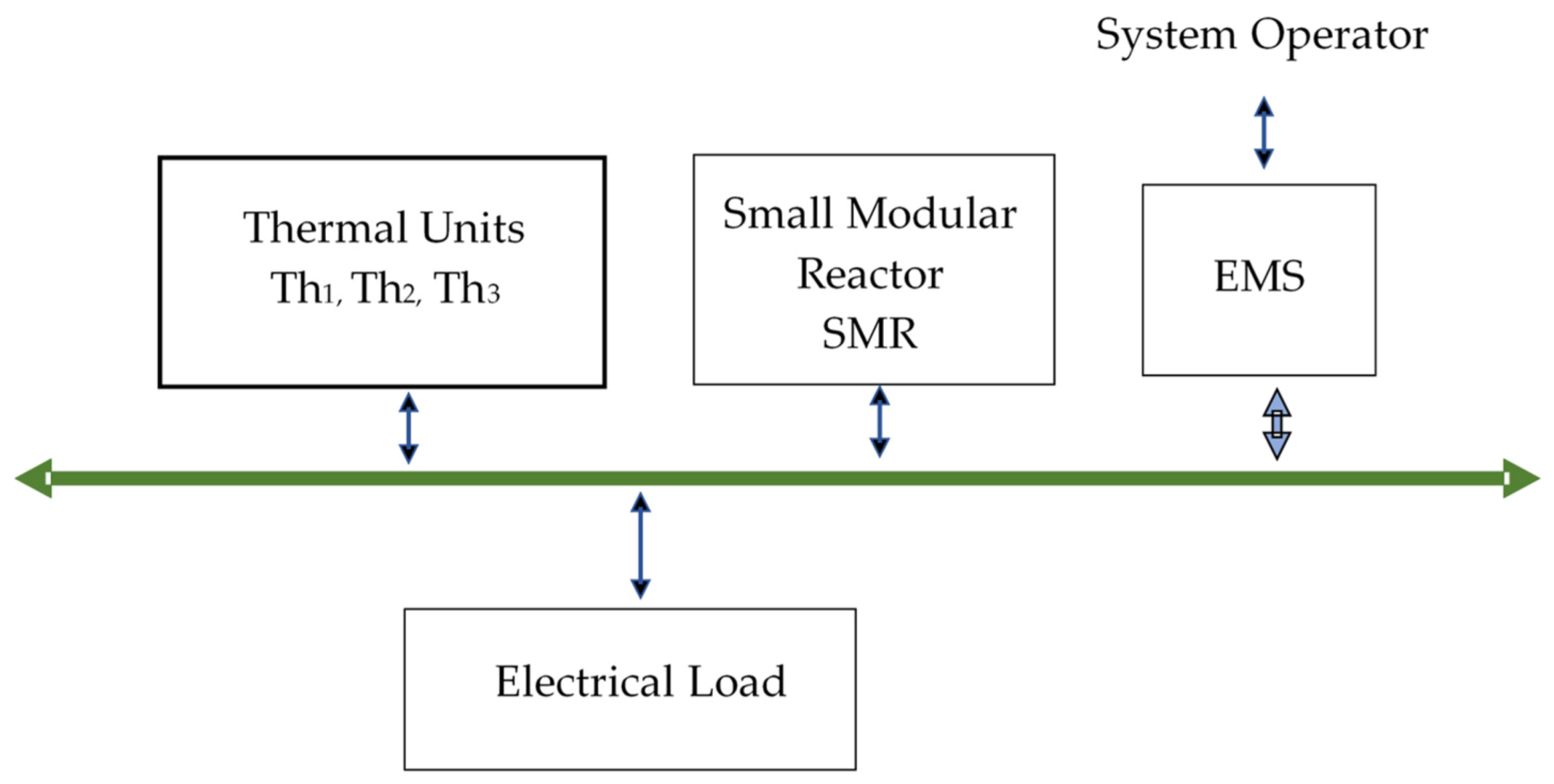
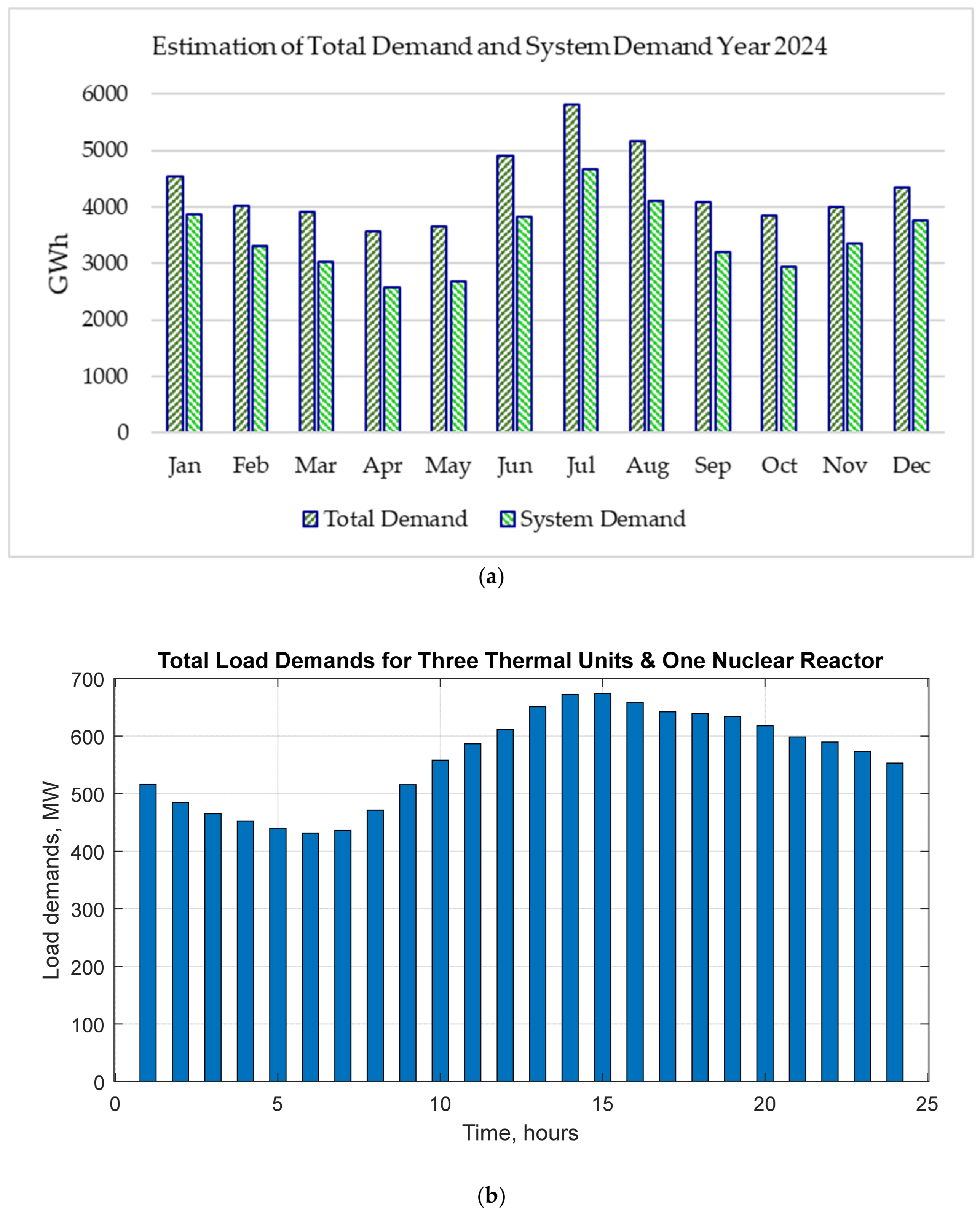
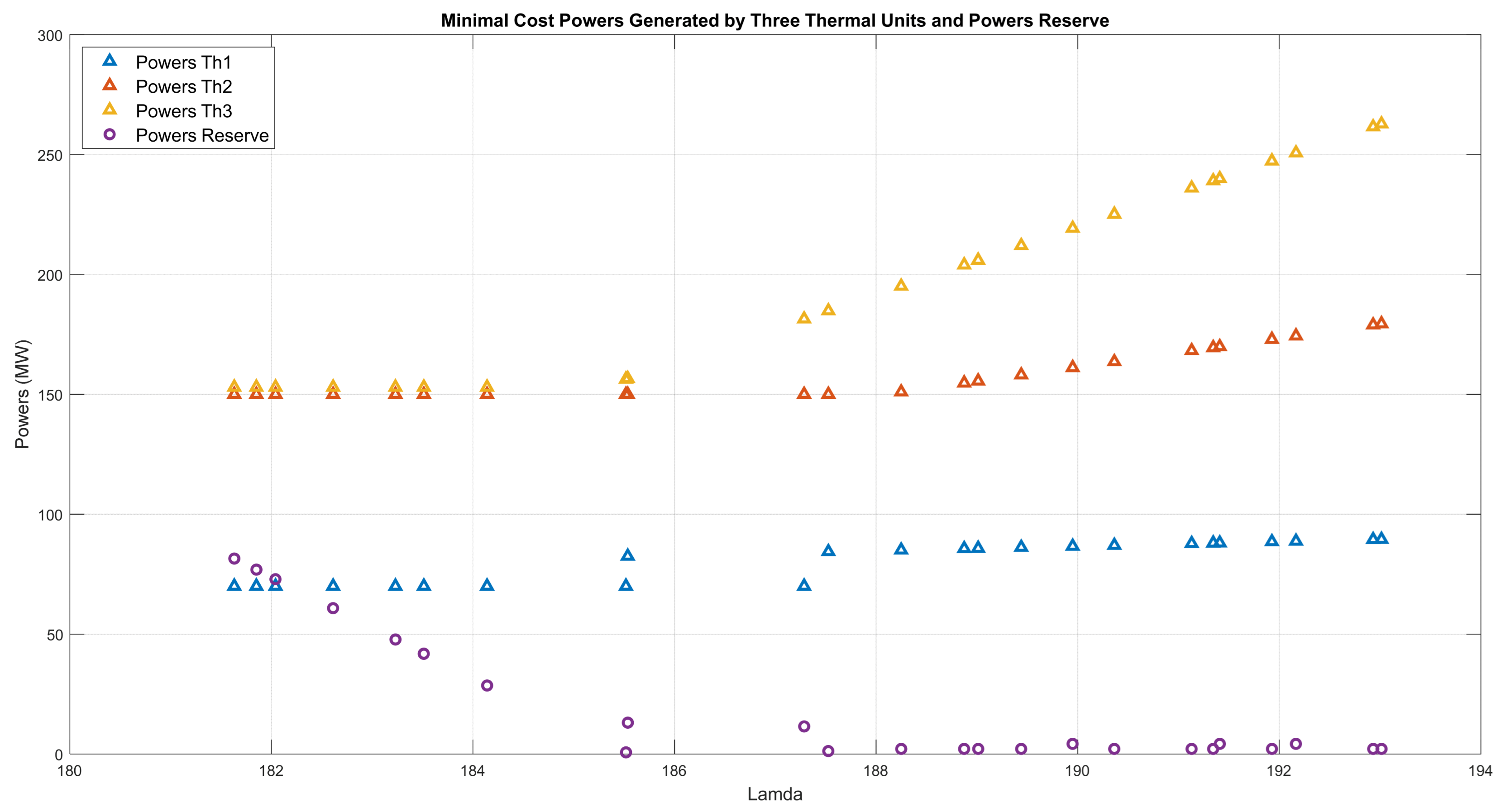
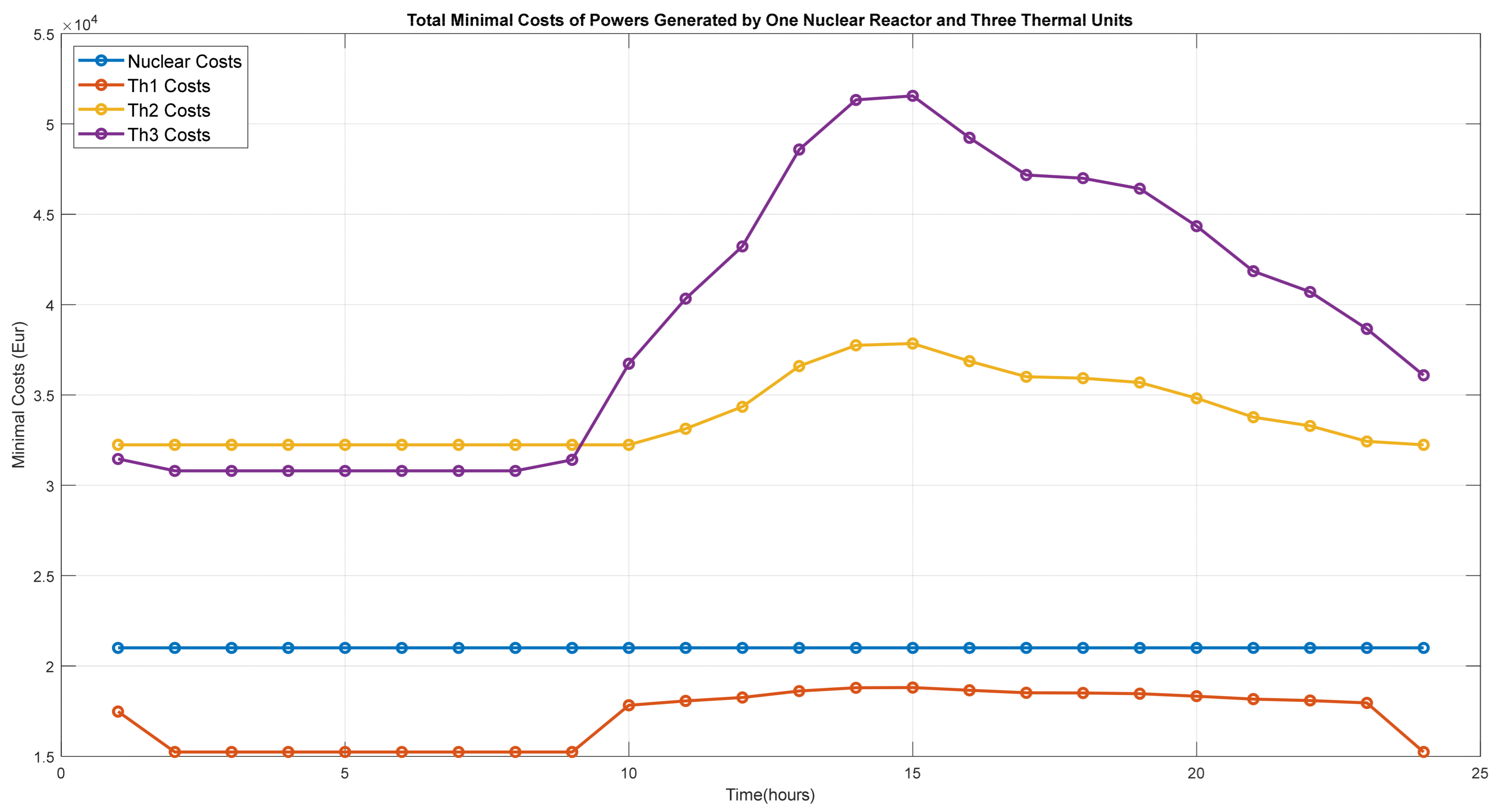
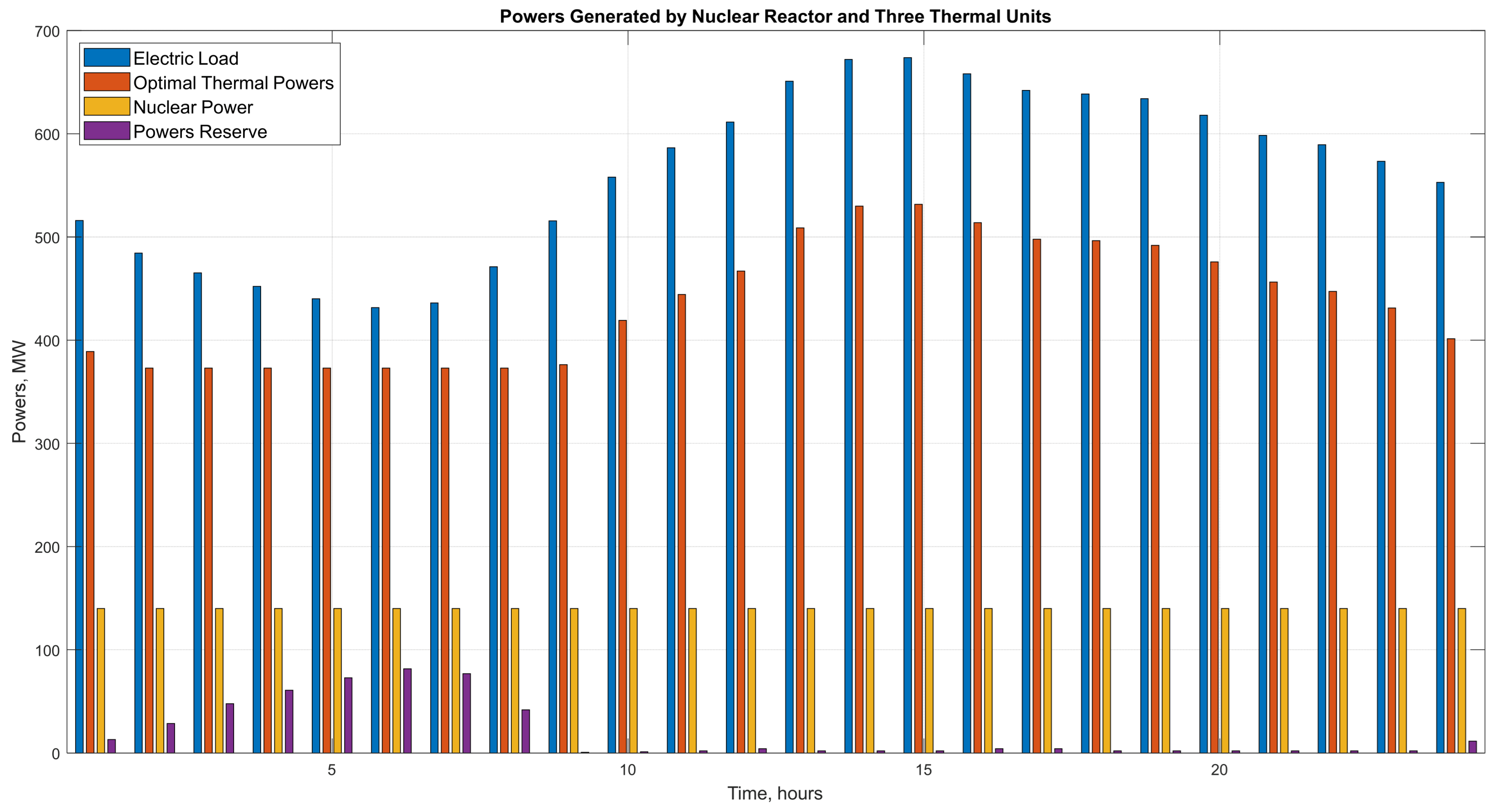
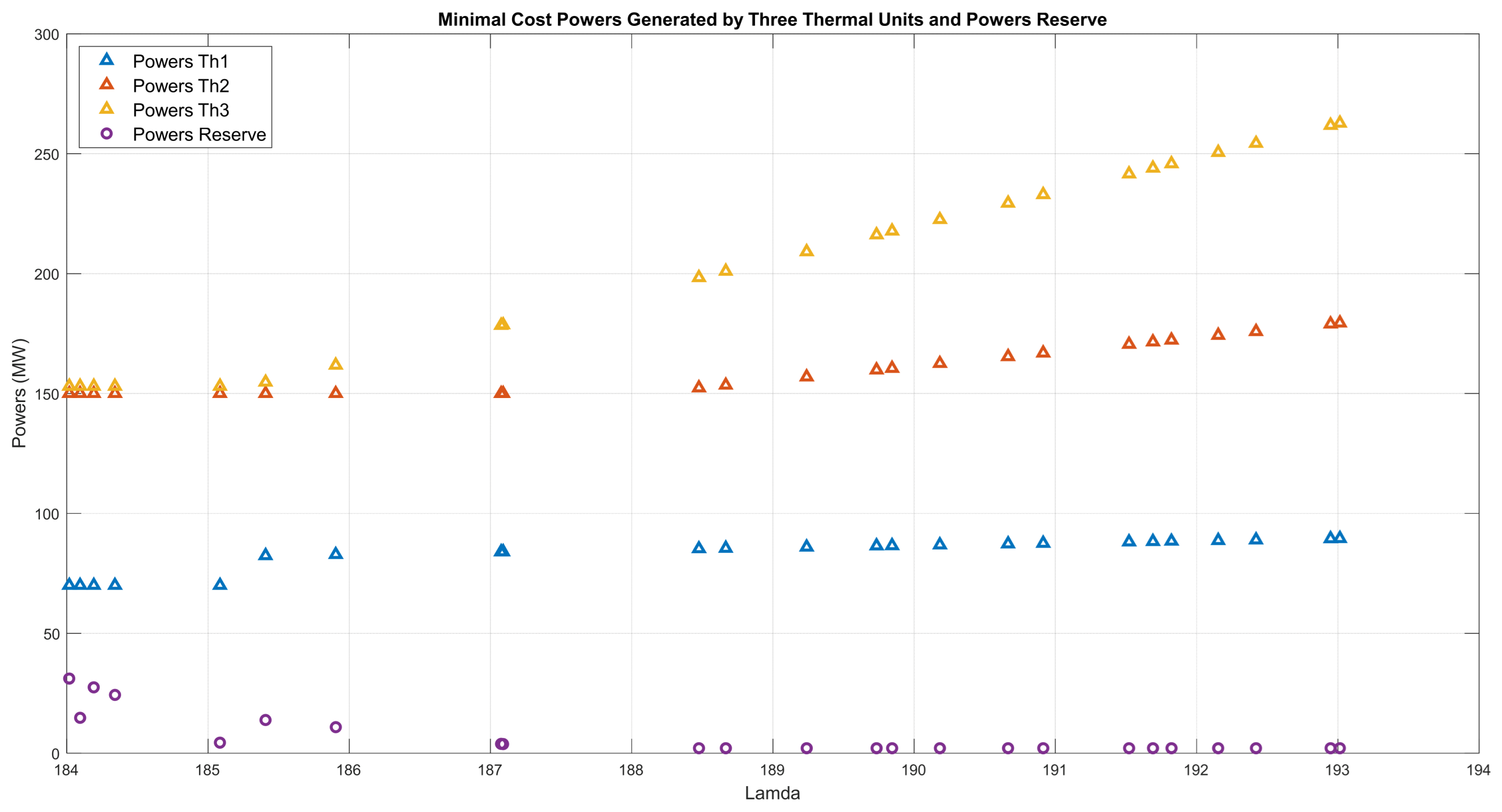
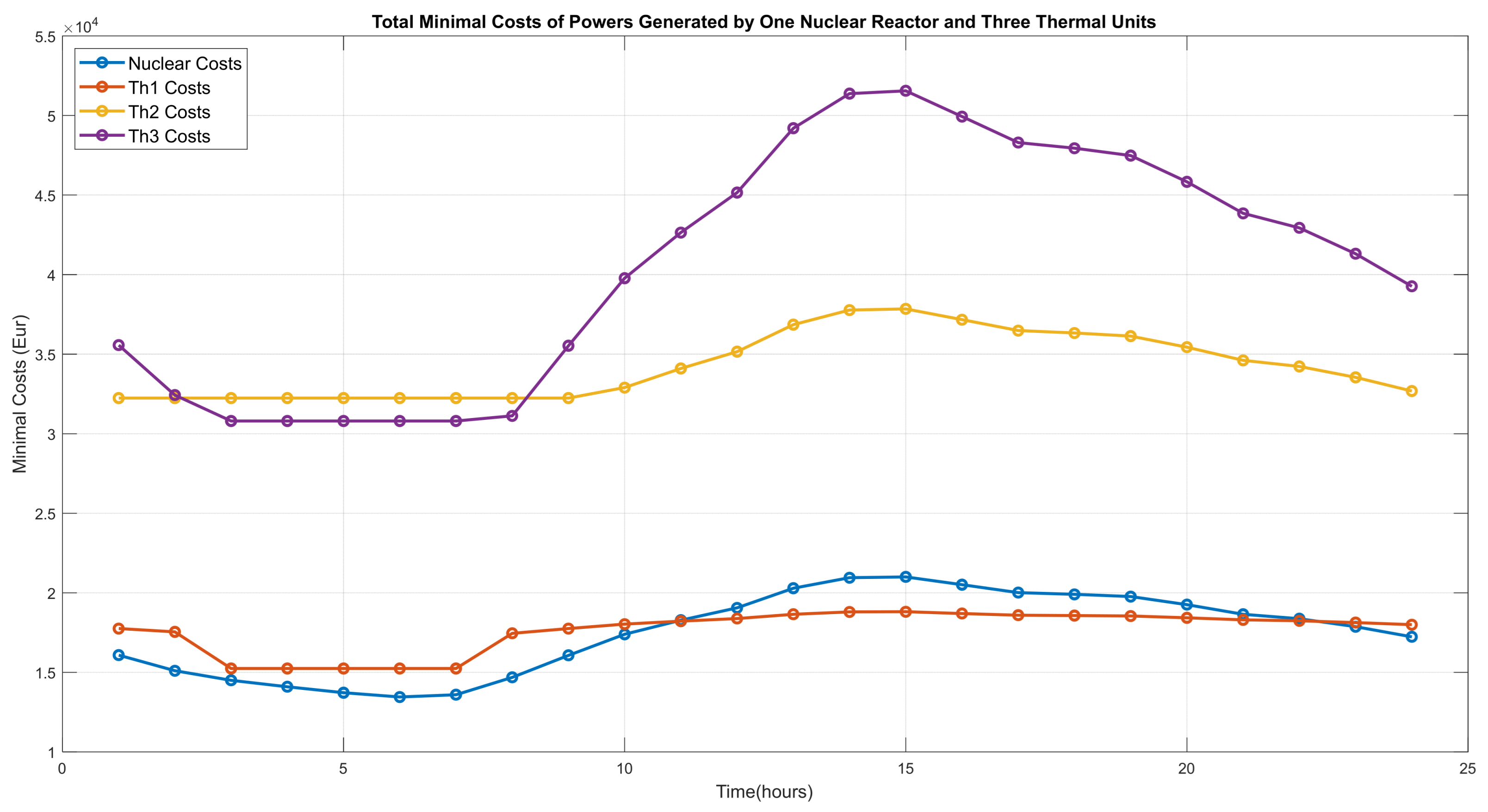

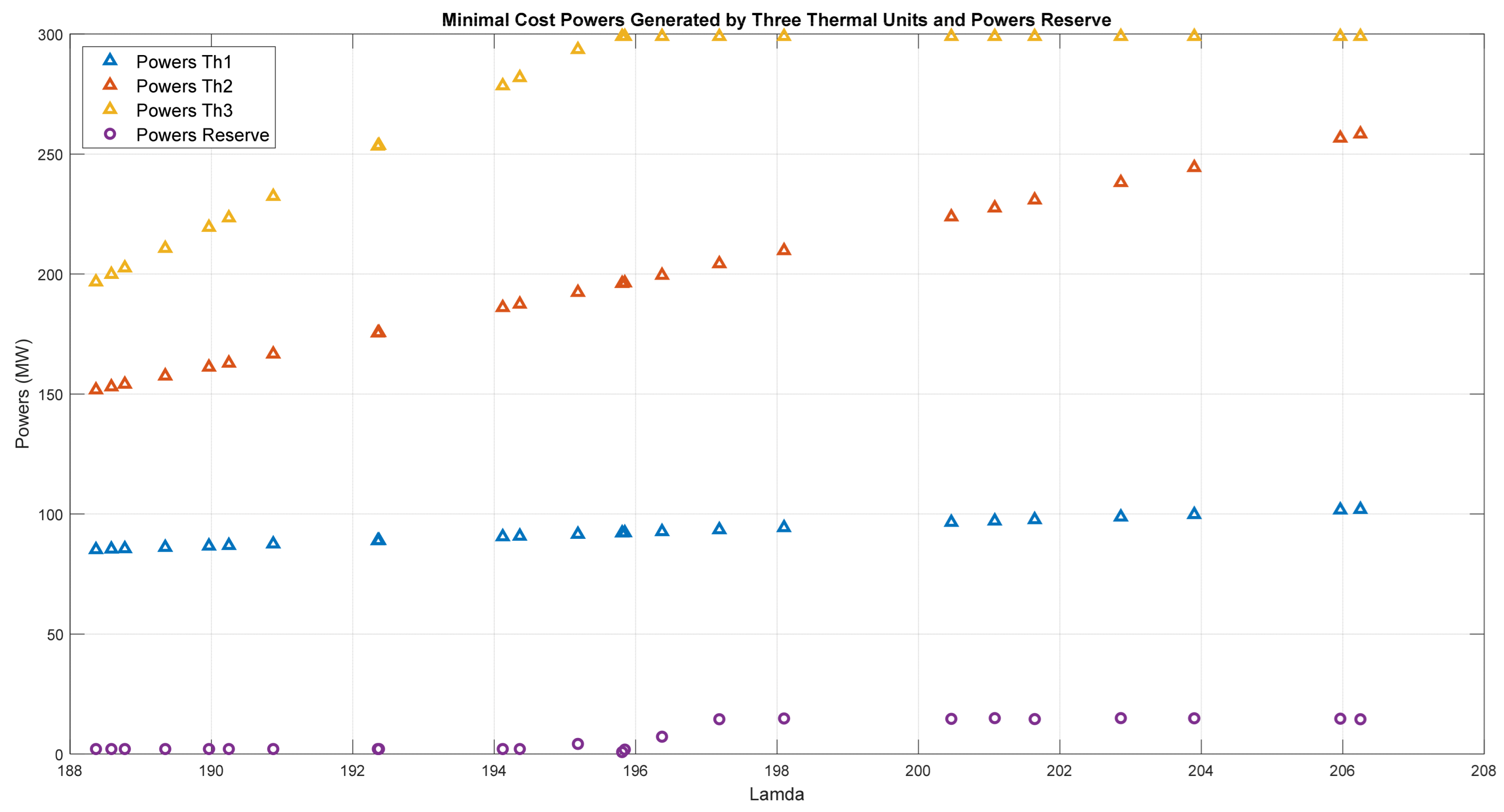
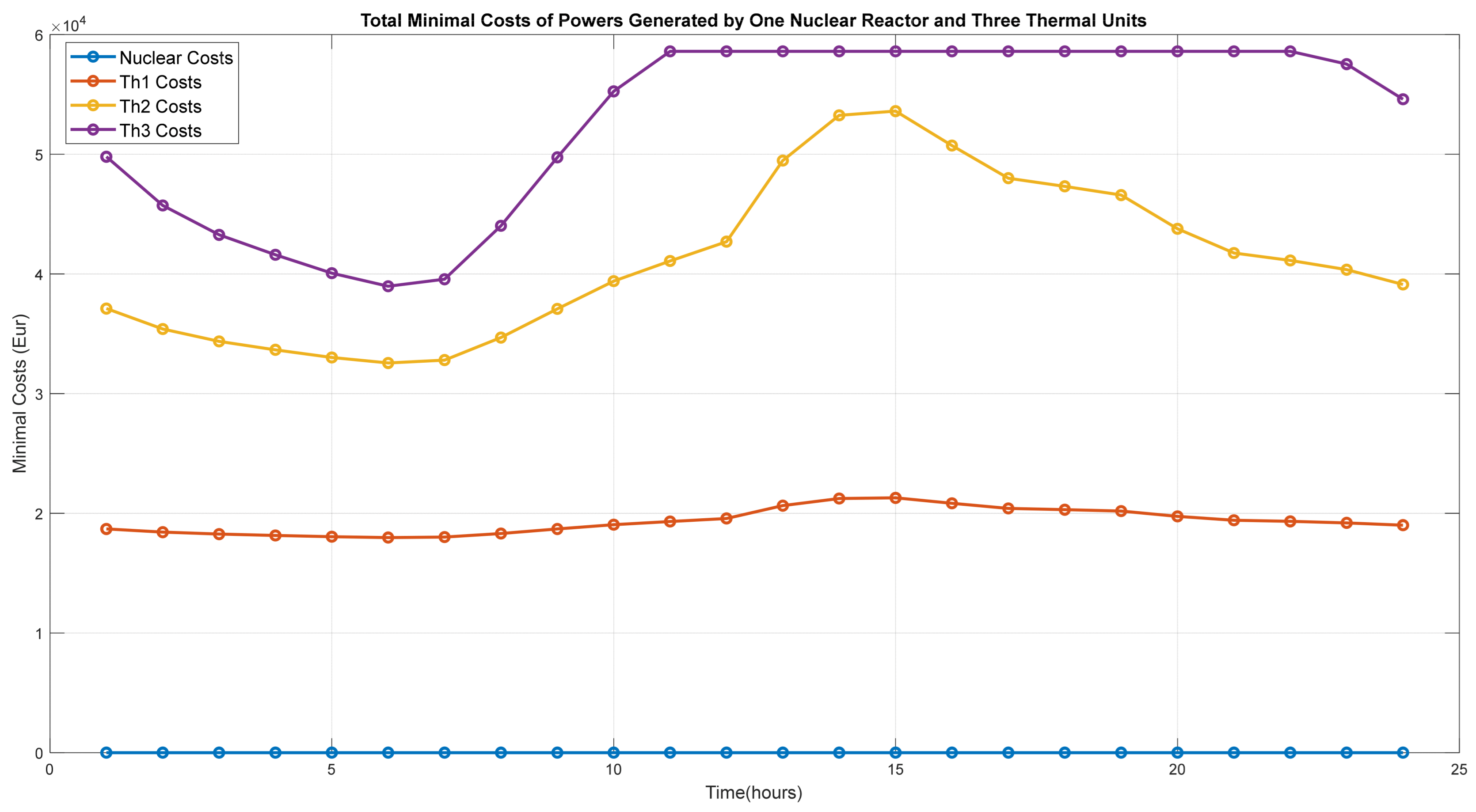



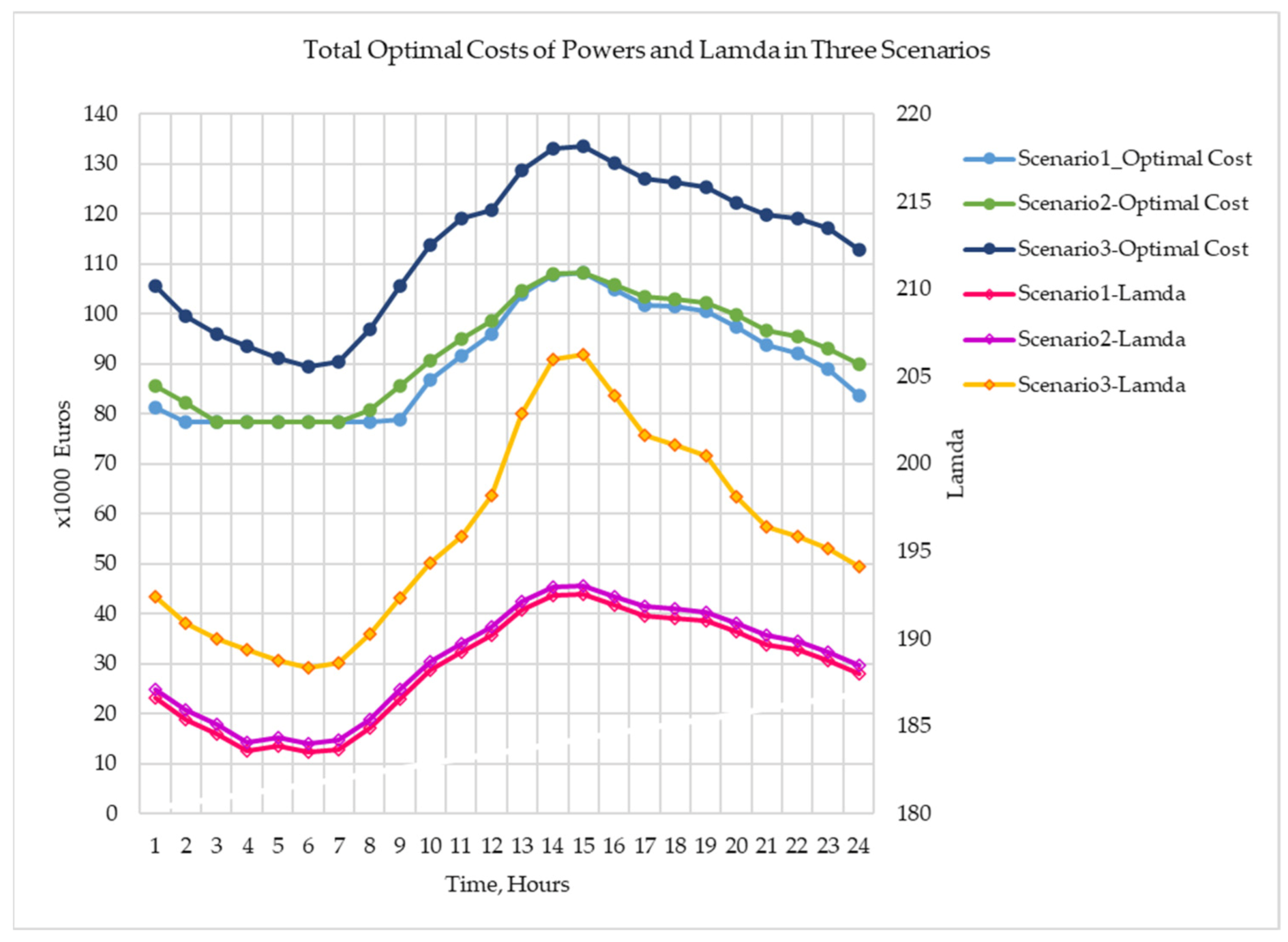
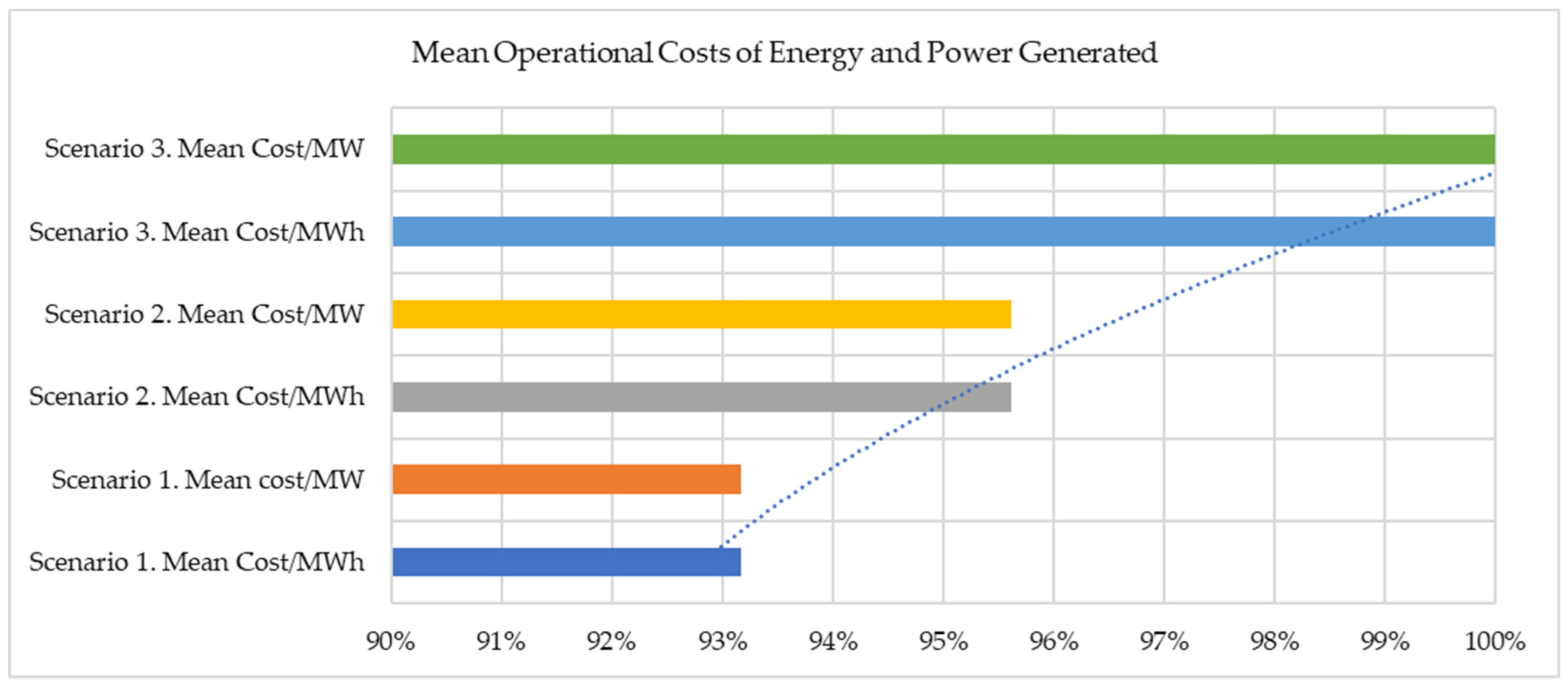
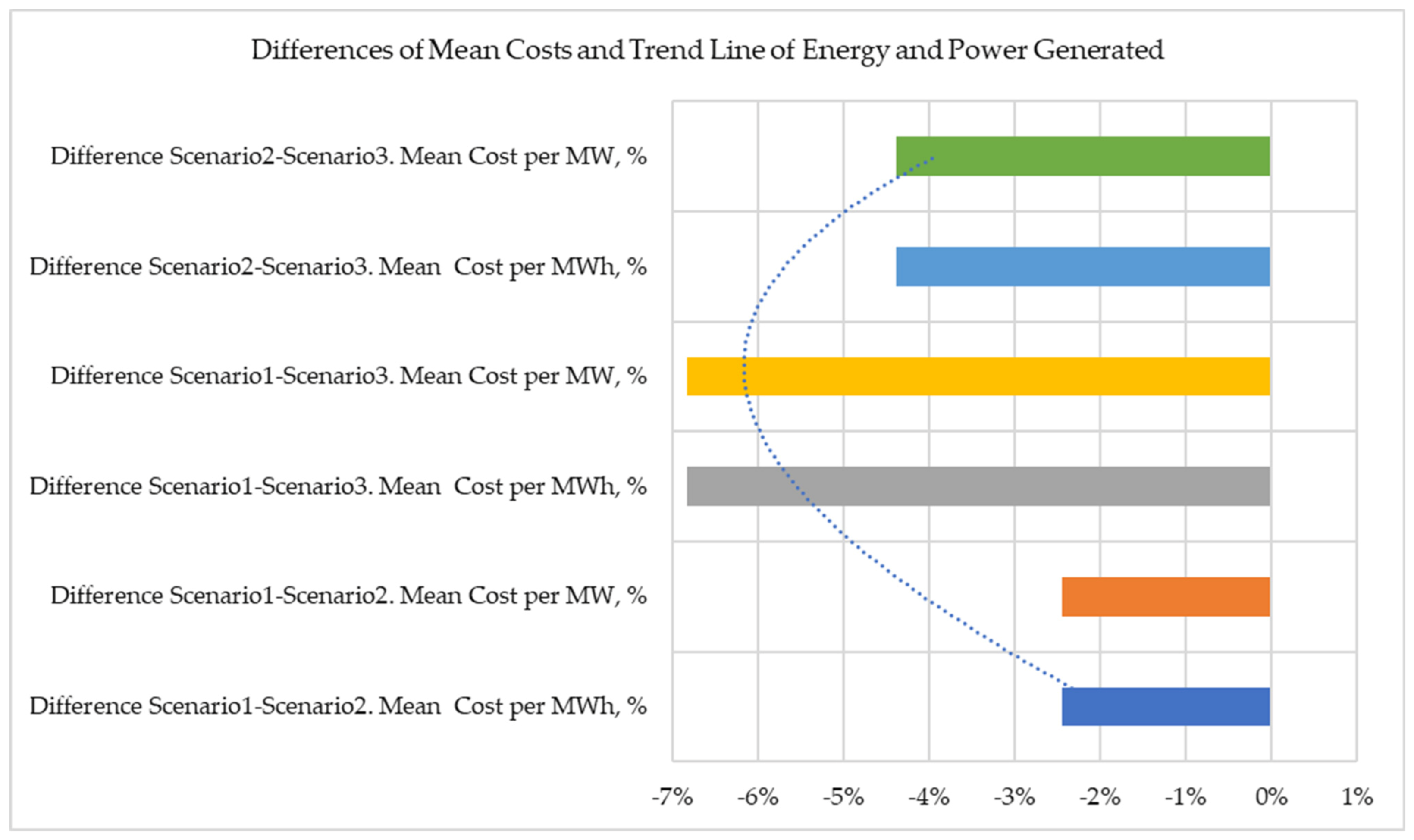

| Power Units | Scenario 1 | Scenario 2 | Scenario 3 | |
|---|---|---|---|---|
| 1. | Nuclear SMR | On, Constant Output = 140 MW | On, Load-Following < 140 MW | Off |
| 2. | Thermal Th1 | On < 130 MW | On < 130 MW | On < 130 MW |
| 3. | Thermal Th2 | On < 300 MW | On < 300 MW | On < 300 MW |
| 4. | Thermal Th3 | On < 300 MW | On < 300 MW | On < 300 MW |
| Electric Load | < 675 MW | < 675 MW | < 675 MW |
| 24 h | SMR | Th1 | Th2 | Th3 | Totals | Totals % |
|---|---|---|---|---|---|---|
| Scenario 1. Energy. MWh | 3360.00 | 1933.03 | 3807.17 | 4748.82 | 13,849.02 | 103.69% |
| Scenario 1. Costs. Eur | 457,800 | 411,657 | 813,080 | 941,647 | 2,624,184 | 96.61% |
| Scenario 1. Cost/Energy. Eur/MWh | 136.25 | 212.96 | 213.57 | 198.29 | 189.49 | 93.17% |
| Scenario 1. SMR Operation Mode | Constant | 24:00–9:00 | 23:00–11:00 | 2:00–8:00 | ||
| Scenario 2. Energy. MWh | 2798.60 | 1996.19 | 3850.90 | 4926.61 | 13,572.30 | 101.62% |
| Scenario 2. Costs. Eur | 419,788 | 423,057 | 821,389 | 975,182 | 2,639,416 | 97.17% |
| Scenario 2. Cost/Energy. Eur/MWh | 150.00 | 211.93 | 213.30 | 197.94 | 194.47 | 95.62% |
| Scenario 2. SMR Operation Mode | Load Following | 3:00–7:00 | 1:00–9:00 | 3:00–7:00 | ||
| Scenario 3. Energy. Base Values. MWh | - | 2212.33 | 4709.75 | 6433.92 | 13,356.00 | 100.00% |
| Scenario 3. Costs, Base Values, Eur | - | 464,060 | 988,967 | 1,263,302 | 2,716,329 | 100.00% |
| Scenario 3. Cost/Energy. Eur/MWh | - | 209.76 | 209.98 | 196.35 | 203.38 | 100.00% |
| Scenario 3. Operation Mode | - | 11:00–22:00 22:00–11:00 |
| 24 h | SMR | Th1 | Th2 | Th3 | All Units | All Units % |
|---|---|---|---|---|---|---|
| Scenario 1. Mean Cost per MWh, Eur/MWh | 136.25 | 212.96 | 213.57 | 198.29 | 189.49 | 93.17% |
| Scenario 1. Mean cost per MW, Eur/MW | 5.68 | 8.87 | 8.90 | 8.26 | 7.90 | 93.17% |
| Scenario 2. Mean Cost per MWh, Eur/MWh | 150.00 | 211.93 | 213.30 | 197.94 | 194.47 | 95.62% |
| Scenario 2. Mean Cost per MW, Eur/MW | 6.25 | 8.83 | 8.89 | 8.25 | 8.10 | 95.62% |
| Scenario 3. Mean Cost per MWh, Eur/MWh | 209.76 | 209.98 | 196.35 | 203.38 | 100.00% | |
| Scenario 3. Mean Cost per MW, Eur/MW | 8.74 | 8.75 | 8.18 | 8.47 | 100.00% |
| SMR | Th1 | Th2 | Th3 | All Units | All Units % | |
|---|---|---|---|---|---|---|
| Difference Scenario 1–Scenario 2. Mean Cost per MWh, Eur/MWh | −13.75 | 1.03 | 0.27 | 0.35 | −4.99 | −2.45% |
| Difference Scenario 1–Scenario 2. Mean Cost per MW, Eur/MW | −0.57 | 0.04 | 0.01 | 0.01 | −0.21 | −2.45% |
| Difference Scenario 1–Scenario 3. Mean Cost per MWh, Eur/MWh | 136.25 | 3.20 | 3.58 | 1.94 | −13.89 | −6.83% |
| Difference Scenario 1–Scenario 3. Mean Cost per MW, Eur/MW | 5.68 | 0.13 | 0.15 | 0.08 | −0.58 | −6.83% |
| Difference Scenario 2–Scenario 3. Mean Cost per MWh, Eur/MWh | 150.00 | 2.17 | 3.32 | 1.59 | −8.91 | −4.38% |
| Difference Scenario 2–Scenario 3. Mean Cost per MW, Eur/MW | 6.25 | 0.09 | 0.14 | 0.07 | −0.37 | −4.38% |
| SMR | Th1 | Th2 | Th3 | Total Thermal | Totals Nuclear and Thermal | Totals % | |
|---|---|---|---|---|---|---|---|
| Scenario 1. Energy. MWh | 3360.00 | 1933.03 | 3807.17 | 4748.82 | 10,489.02 | 13,849.02 | 103.69% |
| Scenario 1. CO2 Emissions. gCO2/MWh | 0.00 | 2319.64 | 4568.60 | 5698.58 | 12,586.82 | 12,586.82 | 78.53% |
| Scenario 2. Energy. MWh | 2798.60 | 1996.19 | 3850.90 | 4926.61 | 10,773.70 | 13,572.30 | 101.62% |
| Scenario 2. CO2 Emissions. gCO2/MWh | 0.00 | 2395.43 | 4621.08 | 5911.93 | 12,928.44 | 12,928.44 | 80.67% |
| Scenario 3. Energy. MWh | 0.00 | 2212.33 | 4709.75 | 6433.92 | 13,356.00 | 13,356.00 | 100.00% |
| Scenario 3. CO2 Emissions. gCO2/MWh | 0.00 | 2654.80 | 5651.70 | 7720.70 | 16,027.20 | 16,027.20 | 100.00% |
Disclaimer/Publisher’s Note: The statements, opinions and data contained in all publications are solely those of the individual author(s) and contributor(s) and not of MDPI and/or the editor(s). MDPI and/or the editor(s) disclaim responsibility for any injury to people or property resulting from any ideas, methods, instructions or products referred to in the content. |
© 2025 by the author. Licensee MDPI, Basel, Switzerland. This article is an open access article distributed under the terms and conditions of the Creative Commons Attribution (CC BY) license (https://creativecommons.org/licenses/by/4.0/).
Share and Cite
Papazis, S.A. Nuclear–Thermal Power Generation: Multicriteria Optimization of the Economic Sustainability. Sustainability 2025, 17, 4781. https://doi.org/10.3390/su17114781
Papazis SA. Nuclear–Thermal Power Generation: Multicriteria Optimization of the Economic Sustainability. Sustainability. 2025; 17(11):4781. https://doi.org/10.3390/su17114781
Chicago/Turabian StylePapazis, Stylianos A. 2025. "Nuclear–Thermal Power Generation: Multicriteria Optimization of the Economic Sustainability" Sustainability 17, no. 11: 4781. https://doi.org/10.3390/su17114781
APA StylePapazis, S. A. (2025). Nuclear–Thermal Power Generation: Multicriteria Optimization of the Economic Sustainability. Sustainability, 17(11), 4781. https://doi.org/10.3390/su17114781






